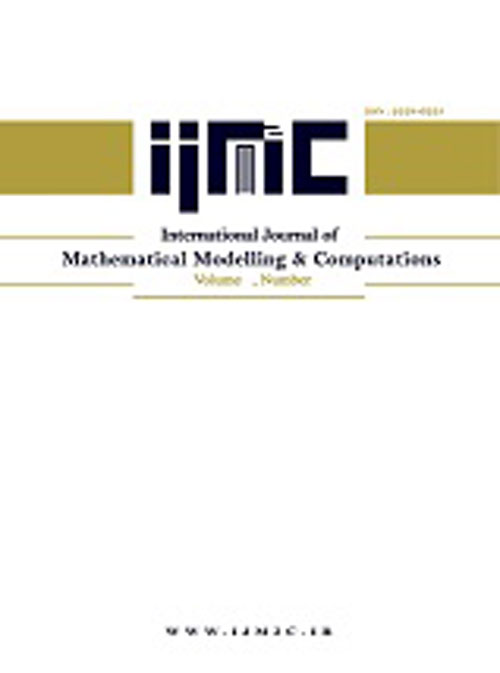فهرست مطالب

مجله بین المللی محاسبات و مدل سازی ریاضی
سال هشتم شماره 4 (Autumn 2018)
- تاریخ انتشار: 1397/06/10
- تعداد عناوین: 6
-
Pages 207-216In this paper, we study a single server Markovian queue with state dependent accessible services, reneging and feedback of customers. The server can accommodate at the most $d$ customers in the service station, after which the new arrivals have to wait in the primary queue of infinite waiting space. All arrivals demand First Essential Service (FES), after completing FES, customers decide to join the second optional Service (SOS) with a probability. The services occur singly according to first come first served service discipline and service times in FES and SOS are exponentially distributed. A customer waiting in the primary queue may get impatient and renege from the queue. However, after completing SOS, if the customer is not satisfied with the service quality, he may join the queue again (feedback). The system is analyzed by a quasi birth-death process and the steady state probabilities of the model are obtained using matrix geometric method. Some performance measures and numerical illustrations are also provided. An optimization of the cost function is performed to find the optimal service rate that minimizes the total cost.Keywords: Queue, First essential service, Second optional service, Reneging, Feedback
-
Pages 217-226In this paper, Adomian decomposition method (ADM) and Laplace decomposition method (LDM) used to obtain series solutions of Burgers-Huxley and Burgers-Fisher Equations. In ADM the algorithm is illustrated by studying an initial value problem and LDM is based on the application of Laplace transform to nonlinear partial differential equations. In ADM only few terms of the expansion are required to obtain the approximate solution which is found to be accurate and effcient and in LDM does not need linearization, weak nonlinearity assumptions, or perturbation theory. These methods are used to solve the examples and the results are presented in the tables.Keywords: ADM, LDM, Burger', s-Huxley Equation, Burger', s-Fisher Equation
-
Pages 227-238The matrix inversion plays a signifcant role in engineering and sciences. Any nonsingular square matrix has a unique inverse which can readily be evaluated via numerical techniques such as direct methods, decomposition scheme, iterative methods, etc. In this research article, first of all an algorithm which has fourth order rate of convergency with conditional stability will be proposed. Then, for solving stability issue, we introduce a coupled stable scheme that can evaluate the matrix inversion with very acceptable accuracy. Furthermore, the convergence and stability properties of the proposed schemes will be analyzed in details. Numerical experiments are adopted to illustrate the properties of the modified methods.Keywords: Matrix inversion, Iterative methods, Convergence, Stability, Coupled recursion
-
Pages 239-254In this paper, the optimal control of transmission dynamics of hand, foot and mouth disease (HFMD), formulated by a compartmental deterministic SEIPR (Susceptible-Incubation (Exposed)- Infected - Post infection virus shedding - Recovered) model with vaccination and treatment as control parameters is considered. The objective function is based on the combination of minimizing the number of infected individuals and the cost involved in the interventions of vaccination given to the susceptible population and treatment given to the infected population. The existence for the optimal control pair is proved and the characterization of the optimal control pair is obtained by applying the Pontryagin's maximum principle. The variational iteration method is adopted to solve the non-linear Hamilton equations derived from the Pontryagin's maximum principle theory. These equations constitute a two-point boundary value problem. By considering the correction functionals of the Hamilton equations, the Lagrange multipliers are easily identified and practical iteration formulas are derived. An algorithm is developed, based on this formulas, to determine iteratively the solutions of the Hamilton equations with a desired accuracy. With the aid of solutions obtained, the optimal control law can be easily deduced. The results were analyzed and interpreted graphically using Maple.Keywords: Hand, Foot, Mouth Disease, Nonlinear System of Differential Equations, Optimal Control, Variational Iteration Method, Numerical Solution
-
Pages 255-258By p-power (or partial p-power) transformation, the Lagrangian function in nonconvex optimization problem becomes locally convex. In this paper, we present a neural network based on an NCP function for solving the nonconvex optimization problem. An important feature of this neural network is the one-to-one correspondence between its equilibria and KKT points of the nonconvex optimization problem. the proposed neural network is proved to be stable and convergent to an optimal solution of the original problem. Finally, an examples is provided to show the applicability of the proposed neural network.Keywords: Neural network, Nonconvex optimization, p-power convexification method, NCP function, Lagrangian function
-
Pages 259-267In this paper, we develop the fuzzy fixed charge transportation problem when the costs are the fuzzy numbers. The first step it transform into the classical fuzzy transportation problem. The next, we obtain the best approximation fuzzy on the optimal value of the fuzzy fixed-charge transportation problem. This method obtains a lower and upper bounds both on the fuzzy optimal value of the fuzzy fixed-charge transportation problem which can be easily obtained by using the approximation solution. Finally, the results of this paper have been illustrated by a numerical example.Keywords: Fixed charge Transportation problem, fuzzy numbers, Transportation problem, Approximation

